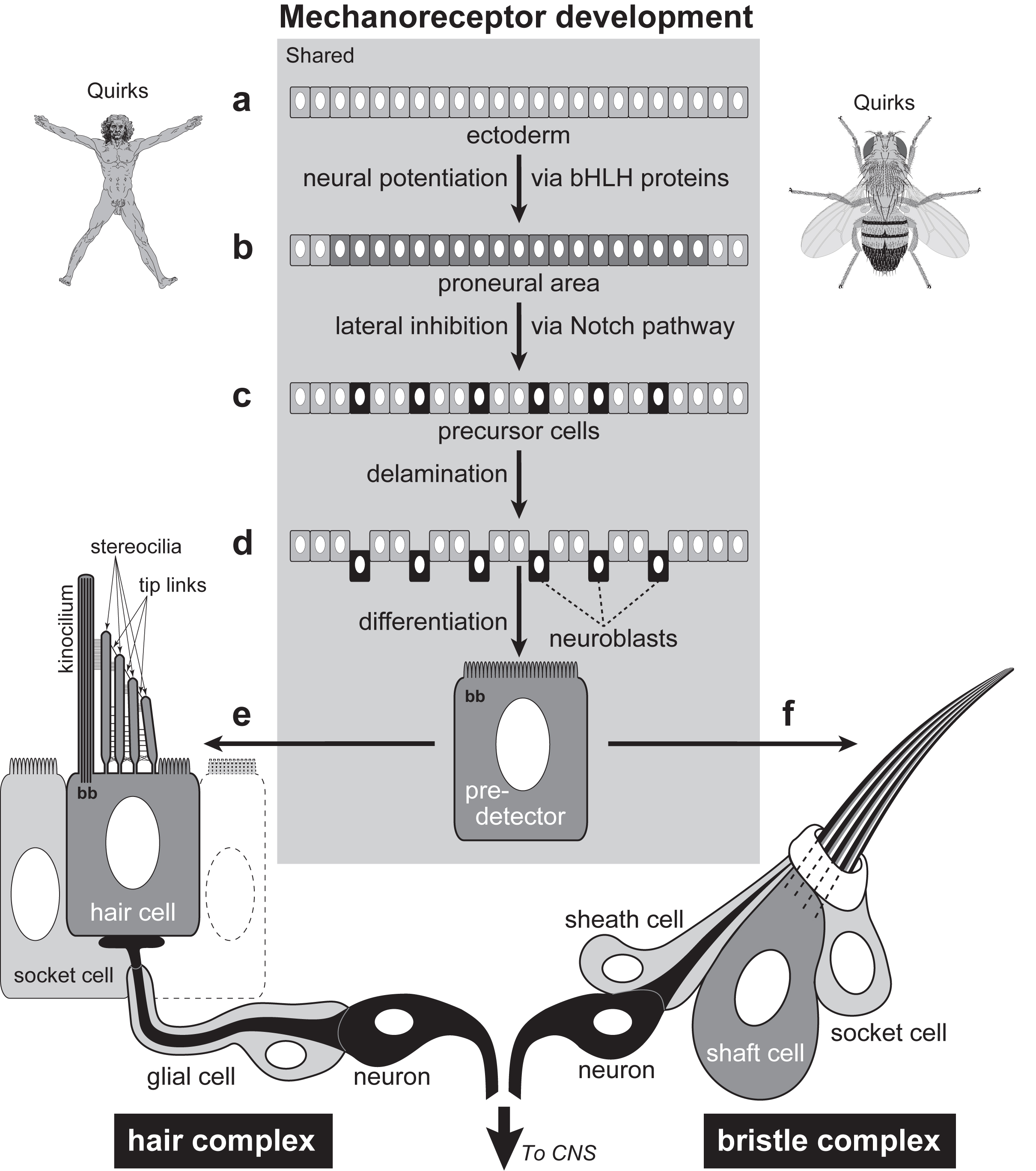

Deep Homology?
  |
Deep Homology? |
 Similarities between the development of cochlear hair cells in vertebrates and bristle cells in insects. a. The cochlear epithelium comes from the ectoderm of the otic placode in humans, and fly skin comes from the ectoderm of imaginal discs. b. Proneural regions (darker gray) are demarcated by bHLH (basic helix-loop-helix) proteins. c. The solid proneural area resolves into punctate sensory organ precursor (SOP) cells via lateral inhibition and lateral induction (not shown) mediated by the Notch pathway. d. The SOPs and their progeny undergo further mitoses, culminating in four cell types, including a neuroblast that delaminates from the epithelium, and a "pre-detector" cell that stays on the surface and elongates its microvilli to form one (f) or more (e) protrusions. Those protrusions become stiff levers -- the stereocilia (e) or the bristle shaft (f) that pivot at their base when deflected. Arrows pointing to e and f indicate that the pre-detector cell becomes the hair cell (e) or shaft cell (f). e. The hair cell (dark gray) transduces tactile inputs into electrical outputs, which are conveyed via a bouton-type synapse to the dendrite of an underlying neuron (black). The glial cell, which comes from the neural crest, ensheathes the dendrite. Socket cells alternate with hair cells in a tiled mosaic. The hair cell converts some of its microvilli into a staircase of "stereocilia". They are not true cilia like the actual "kinocilium" that grows out from the basal body (bb) as a bundle of microtubules (vertical lines). Stereocilia are lashed together by (1) a mesh of "ankle links" at their base, (2) a ladder of "shaft connectors" along their length, (3) a zone of "horizontal top connectors" near the top, and (4) diagonal "tip links" at their apices. When stereocilia are deflected, the tip links pull ion channels open. A simplified staircase is drawn here in side view. Mice have dozens of stereocilia per tuft arranged in the shape of a U, V, or W, and chickens have up to ~450 stereocilia in a rectangular array. Our own cochlea has ~20-300 stereocilia per cell and a total of ~16,000 hair cells. f. Unlike the hair cell complex, the bristle complex arises via a strict pedigree that yields two pairs of sisters (shaft-socket and neuron-sheath). Transduction is also handled differently: the neuron transduces deflections of the shaft into electrical signals via compression of its dendrite. Despite these differences, the fly's shaft cell is thought to be homologous to the cochlear hair cell, both of which elongate their protrusions (shaft or stereocilia) by the stacking of actin bundles (dotted lines in the shaft cell). Those bundles disintegrate in the shaft as it matures (leaving only a legacy of tapered fluting), but they persist in stereocilia (not shown). |
|
Introduction: cover image Body axes: figure 2 | figure 3 | figure 4 | figure 5 | figure 6 Nervous system: figure 7 | figure 8 Vision: figure 9 | figure 10 | figure 11 | figure 12 | figure 13 Touch and hearing: figure 14 | figure 15 Smell and taste: figure 16 Limbs: figure 17 Epilogue: figure 18 The Interactive Fly resides on the web server of the Society for Developmental Biology. |